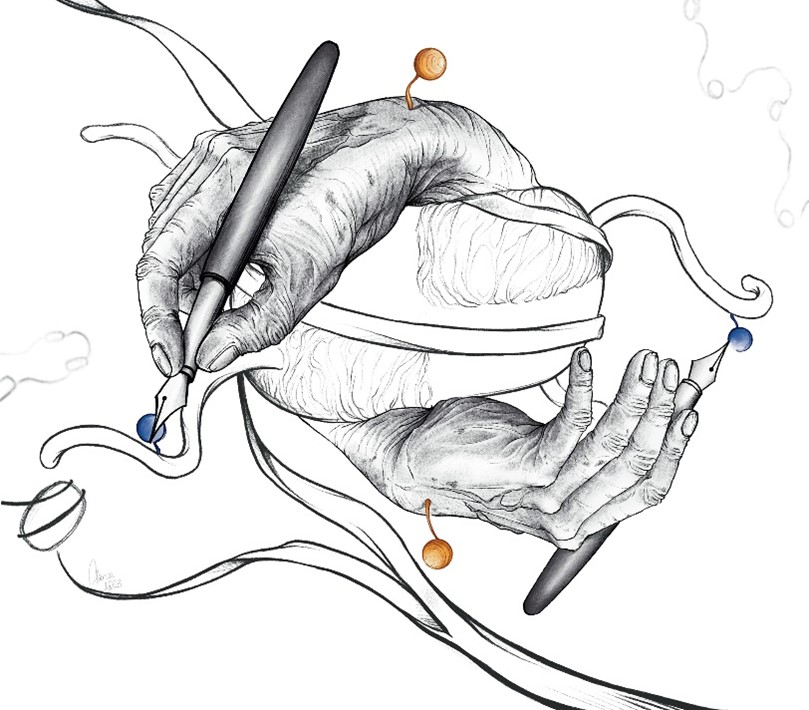Our cells remember their cell type-specific functions during their lifetime using modifications on histones, the proteins packaging DNA. Such epigenetic memory is challenged during DNA replication when histones are evicted from DNA. We reveal new evidence that cells recycle histones H2A-H2B to replicated DNA with their modifications, hereby providing epigenetic memory across cell division.
Expression of a correct set of genes at the right time is crucial for cells to maintain their cell-type specific function. Epigenetic cell memory supports maintenance of such gene expression programs, with specific chromatin states regulating which genes to express or to keep silent. Chromatin is the packaged structure of the genome, which affects access to genes and gene expression. But when cells divide and replicate their DNA, these specific chromatin states are disrupted, and it remains unclear how they are transmitted to daughter cells to maintain correct gene expression programs. In recent years, evidence have emerged that the fundamental packaging unit of the DNA - the nucleosome - is responsible at least in parts for transferring epigenetic memory across DNA replication. Nucleosomes consist of eight proteins called histones: a H3-H4 tetramer and two H2A-H2B dimers. Many chemical modifications of these histones control gene expression. During DNA replication, two DNA daughter strands are generated that will subsequently get separated during cell division, one to each daughter cell. In that process, H3-H4 are accurately transferred with their modifications to both replicated daughter strands. This process is coordinated by specific proteins of the DNA replication machinery itself that bind and transfer these histones to both daughter strands in a symmetric manner. Subsequently, newly synthesized, unmodified histones get deposited. Yet, histone H3-H4 only constitute half of the nucleosome and get transferred as one single tetramer to daughter strands, making this “either new or old H3-H4” process potentially prone to loss of epigenetic information. In addition, mutant cells that recycle H3-H4 to only one daughter strand are viable, indicating that additional mechanisms exist to propagate epigenetic memory during DNA replication.
We hypothesized that the other half of the nucleosome, the two H2A-H2B dimers are likely candidates, but it was difficult to test because H2A-H2B are very dynamic and thus hard to track. To this end, we have developed technologies that allow us to observe these histones directly after DNA replication, thanks to a high temporal and spatial resolution. This technology involves a 10-minute labelling of newly replicated (“nascent”) DNA with a molecule that can then be specifically purified to measure the associated histone modifications.
In a first step, we tested whether we could detect modifications on H2A-H2B on nascent chromatin in mouse embryonic stem cells. Indeed, we saw that, similar to H3-H4, H2A-H2B modifications are present at the correct positions on nascent chromatin already. With further experiments we could show that these modifications are not deposited after the DNA is replicated, but prior to DNA replication, thus demonstrating that H2A-H2B modifications are recycled during DNA replication.
Is this recycling mechanism an alternative pathway to H3-H4? To test this, we tracked the path of modified, recycled H2A-H2B during DNA replication in wild type cells or in different mutant cells where H3-H4 is recycled only to one daughter strand and thus asymmetric. H2A-H2B recycling remained symmetric in most cases, thereby demonstrating that H2A-H2B recycling constitutes an independent recycling pathway. This is very exciting, because it suggests that cells developed parallel mechanisms to ensure faithful inheritance of epigenetic memory during DNA replication and thus implies important function of epigenetic memory in cell division.
Finally, H2A-H2B are propagated as two separate dimers, unlike the H3-H4 tetramer, thus allowing combinations of recycled H2A-H2B with new, unmodified H3-H4. We hypothesized that this combinatorial approach may allow cells to restore the right chromatin state by using recycled H2A-H2B modifications to deposit matching H3-H4 modifications. Such crosstalk has been identified before, but it was difficult to assign it to specific cellular processes. To test this, we removed a specific H2A modification on nascent chromatin and saw that a matching H3 modification was not correctly deposited on new H3-H4 anymore, indicating that histone modification crosstalk is especially important during DNA replication.
In conclusion, we have identified an alternative, independent pathway that propagates epigenetic information by accurately recycling modified histones H2A-H2B during DNA replication. We demonstrate that modifications on recycled H2A-H2B can be crucial in restoring matching modifications on H3-H4. We propose that this restoration happens via crosstalk between H2A-H2B and H3-H4 within the same nucleosomes. This “mix and match” approach ensures that sufficient epigenetic information in the form of histone modifications is transferred to both daughter strands and ultimately across cell division to maintain gene expression programs and cell identity in daughter cells.
In the future, it will be exciting to fully dissect the molecular mechanisms behind H2A-H2B recycling and reveal its impact on chromatin inheritance and cell identity more broadly. This is a fundamental inheritance system operating in all dividing cells and challenges to this process could lead to changes in cell functionality as seen in aging and diseases such as cancer.
Original Article:
Flury, V., Reverón-Gómez, N., Alcaraz, N., Stewart-Morgan, K. R., Wenger, A., Klose, R. J., & Groth, A. (2023). Recycling of modified H2A-H2B provides short-term memory of chromatin states. Cell, 186(5), 1050-1065.e19. https://doi.org/10.1016/j.cell.2023.01.007
 Health & Physiology
Health & Physiology



